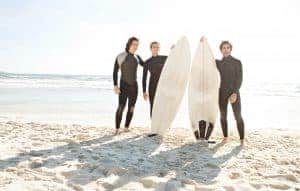Read Time: 5 Minutes
Many people have heard of Swimmer's Ear who have never heard of Surfer's Ear, we take a look at who is at risk.
This article looks at:
- How Surfers Get Surfer's Ear
- Reducing The Affect of Surfer's Ear
- Enjoying The Water With Hearing Aids
Many people have heard of Swimmer’s Ear - a painful infection which inflames the outer ear - but fewer realise there is another condition that affects Australian water-lovers. And it can result in hearing loss, and surfers are particularly at risk.
The condition is called Surfer’s Ear. Its medical name is exostosis, which is abnormal bone growth in the ear canal. When they occur in other parts of the body, they are sometimes called bone spurs.
Repeated cold wind and water exposure results in the bone around the ear canal to build additional growth which restricts the ear canal, making it more susceptible to wax build up and infections.
Unlike Swimmer’s Ear, which can be successfully treated with antibiotics and prevented with the use of earplugs and diligent drying after being in the water, Surfer’s Ear is permanent unless there is surgical intervention.
How Can Surfers Get Surfer's Ear
Surfer’s Ear is more prevalent among cold water surfers - in fact, it can be seen in between 60% to 80% of surfers - but it can and does occur in surfers, kite surfers, kayakers and windsurfers in Australia’s balmy waters.
The condition is progressive and typically it is only when surfers are aged in their 30s or 40s that people seek treatment for hearing loss.
If the condition is left untreated, it can completely block the ear canal.
Treatment involves the delicate procedure of either chiselling or drilling out the bone - and surfers will have to stay out of the water for several weeks while the ear heals. If the ears have been subjected to repeated infections, then there may be a risk of more serious hearing loss.
Reducing The Risk of Surfer's Ears
While some kind of Surfer’s Ear appears to be inevitable, there are things which watersport lovers can do to reduce the risk:
- Avoid activity during extremely cold or windy conditions.
- Keep the ear canal as warm and dry as possible.
- Wear ear plugs in the water
- In surfing in very cold conditions, also invest in a wetsuit with a hood
- Depending on your sport, swim caps may also help protect the ears
Enjoying the water with hearing aids
Unfortunately there is no such thing as a completely waterproof hearing aid, but that doesn’t means you can’t enjoy the great outdoors - it just takes a little more planning.
- Take a waterproof container with you to the beach to place your hearing aids in to prevent sand and moisture getting in. Never keep your hearing aids in the car, particularly in summer where extreme heat may affect them
- Protect your ears. If you’re going to spend the day in the water, consider using ear plugs
- Dry your ears thoroughly to prevent infection.
- Slap on a hat - extreme sunlight and UV is not good for you or your hearing aids. Wearing a hat solves both problems
- Make a daily clean of your hearing aids a part of your routine - particularly in summer months to prevent sunscreens, insect repellents build up as well as any clogging from sand or sea salt.
- Invest in a hearing aid dryer/dehumidifier - especially handy for Australian summers in Queensland and New South Wales. Sweat and moisture build up is no good for hearing aids.
- If your hearing aids are battery operated, ensure the case and the battery doors are left open overnight.
Further Reading
Value Hearing cares about you and your on-going hearing health. We have articles on other causes of hearing loss here.
- What Is Meniere's Disease?
- What Is An Outer Ear Infection?
- How Noise Hurts Your Hearing (Even If You Can't Hear It)
- The Problem With Noise Needs To Be Out In The Open
- Ear Wax, Friend Or Foe?
- How To Safely Remove Ear Wax At Home
- How To Protect Your Hearing During Cold and Flu Season
- Health Issues That Affect Hearing


